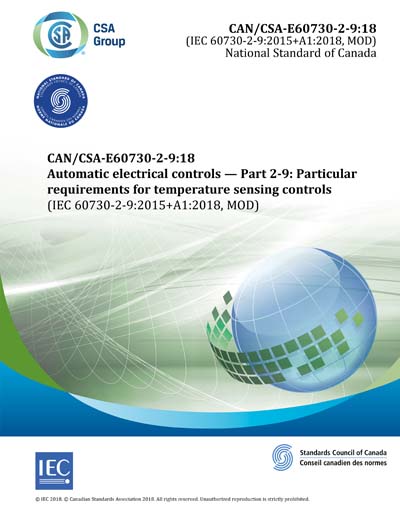Historical
CAN/CSA E60730-2-9-2018
Automatic electrical controls - Part 2-9: Particular requirements for temperature sensing controls (Adopted IEC 60730-2-9:2018, edition 4:2015 consolidated with amendment 1:2018, with Canadian deviations)
CSA Preface This is the fourth edition of CAN/CSA-E60730-2-9, Automatic electrical controls— Part 2-9: Particular requirements for temperature sensing controls, which is an adoption, with Canadian deviations, of the identically titled IEC (International Electrotechnical Commission) Standard 60730-2-9 (edition 4:2015 consolidated with Amendment 1:2018). It supersedes the previous edition published in 2015 as CAN/CSA-E60730-2-9 (adopted IEC 60730-2-9:2008+A1:2011). At the time of publication, IEC 60730-2-9:2015+A1:2018 is available from IEC in English only. CSA Group will publish the French version when it becomes available from IEC. For brevity, this Standard will be referred to as "CAN/CSA-E60730-2-9" throughout. This Standard is intended to be used in conjunction with CAN/CSA-E60730-1:15, Automatic electrical controls — Part 1: General requirements (adopted IEC 60730-1:2013, with Canadian deviations). This edition includes alignment with the text of CAN/CSA-E60730-1:15 and the following significant technical changes with respect to the previous edition: a) modification of heating-freezing tests in Clause 12; b) alignment of the EMC requirements in Clause H.26 to those in other part 2 standards; and c) addition of requirements in Clause H.27 to cover class B and C control functions of temperature sensing controls. This Standard has been developed in compliance with Standards Council of Canada requirements for National Standards of Canada. It has been published as a National Standard of Canada by CSA Group. Scope This clause of Part 1 is applicable except as follows: 1.1 Scope Replacement: This part of IEC 60730 applies to automatic electrical temperature sensing controls for use in, on or in association with equipment, including electrical controls for heating, air-conditioning and similar applications. The equipment may use electricity, gas, oil, solid fuel, solar thermal energy, etc., or a combination thereof. NOTE Throughout this standard, the word "equipment" includes "appliance" and "control system". This standard is applicable to automatic electrical temperature sensing controls forming part of a building automation control system within the scope of ISO 16484. This standard also applies to automatic electrical temperature sensing controls for equipment that may be used by the public, such as equipment intended to be used in shops, offices, hospitals, farms and commercial and industrial applications. This standard does not apply to automatic electrical temperature sensing controls intended exclusively for industrial process applications, unless explicitly mentioned in the relevant equipment standard. 1.1.1 Replacement: This standard applies to the inherent safety, to the operating values, operating times, and operating sequences where such are associated with equipment safety, and to the testing of automatic electrical temperature sensing control devices used in, or in association with, equipment. NOTE Examples of such controls include boiler thermostats, fan controls, temperature limiters and thermal cut-outs. This standard is also applicable to the functional safety of low complexity safety-related temperature sensing controls and systems. 1.1.2 Addition: This standard also applies to the electrical safety of temperature sensing controls with nonelectrical outputs such as refrigerant flow and gas controls. 1.1.3 Not applicable. 1.1.4 Replacement: This standard applies to manual controls when such are electrically and/or mechanically integral with automatic temperature sensing controls. NOTE Requirements for manual switches not forming part of an automatic control are contained in IEC 61058-1. 1.1.5 Replacement: This standard applies to a.c. or d.c. powered temperature sensing controls with a rated voltage not exceeding 690 V a.c. or 600 V d.c. 1.1.6 Replacement: This standard does not take into account the response value of an automatic action of a temperature sensing control, if such a response value is dependent upon the method of mounting it in the equipment. Where a response value is of significant purpose for the protection of the user, or surroundings, the value defined in the appropriate equipment standard or as determined by the manufacturer shall apply. 1.1.7 Replacement: This standard applies also to temperature sensing controls incorporating electronic devices, requirements for which are contained in Annex H and to temperature sensing controls using NTC thermistors or PTC thermistors, requirements for which are contained in Annex J. Additional subclause: 1.1.101 This standard applies to single operation devices as defined in this standard.
CSA America, Inc. [csa]

